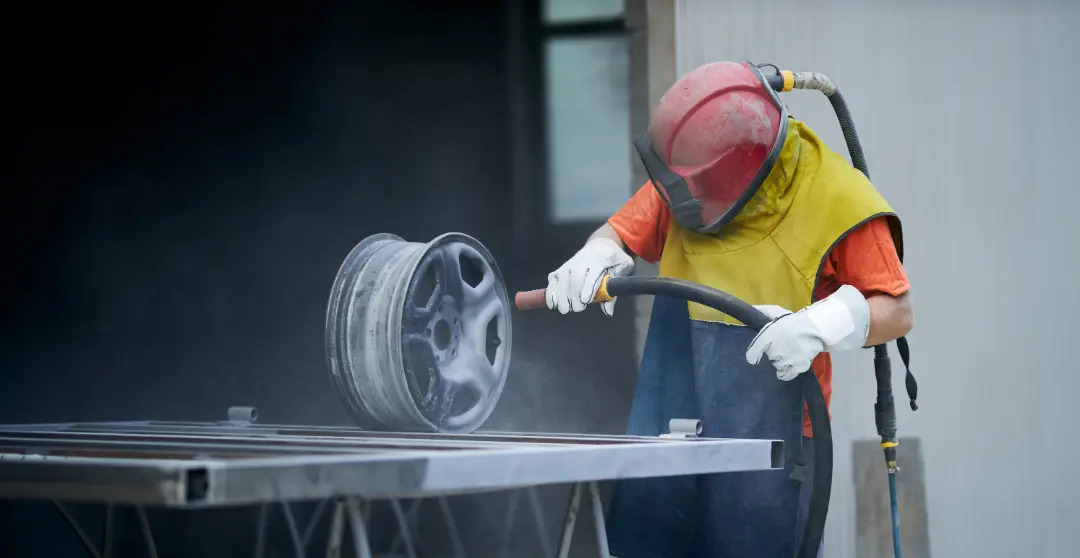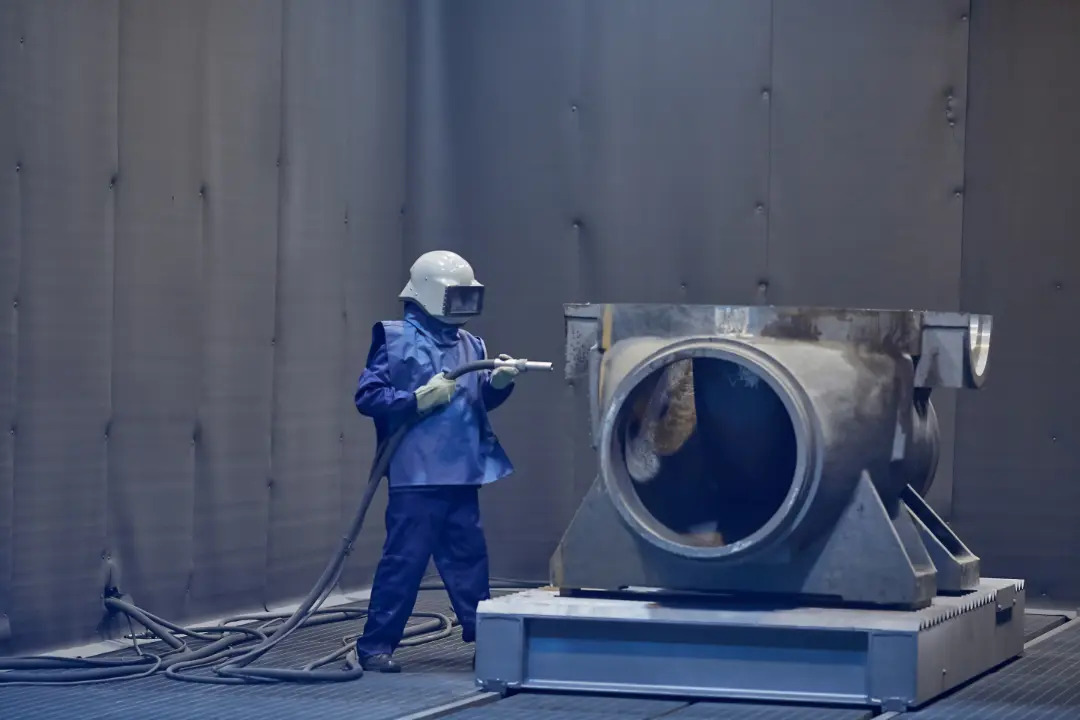Top Things to Consider Before Sandblasting Brickwork
Tuesday December 3, 2024
Before sandblasting brickwork, several important things must be considered, including understanding the process, assessing the brick’s condition, choosing the right abrasive material, and considering the impact on mortar joints and safety precautions.
These steps help ensure effective and safe results.
Key Takeaways
- Careful assessment of brick condition is essential before sandblasting to prevent damage, particularly for older or softer bricks.
- Choosing the appropriate abrasive material based on the bricks’ condition is vital for effective cleaning and maintaining structural integrity.
- Environmental considerations and safety precautions are critical during sandblasting to minimise health risks and ecological impact.
Understanding Sandblasting
Sandblasting, often referred to as abrasive blasting, is a highly effective method for cleaning surfaces by propelling abrasive materials, such as sand, against them using high-pressure air. Brick sandblasting often uses this technique to remove paint, mildew, and graffiti, restoring the brick’s original beauty.
Abrasive materials like sand, walnut shells, or crushed glass are blasted at high speeds to clean and prepare surfaces. This method is particularly useful for brick cleaning, as it can remove years of accumulated dirt and grime, leaving the surface looking almost new. However, the choice of abrasive material can significantly impact the effectiveness and safety of the process.
Different materials serve different purposes. For instance, walnut shells are less aggressive and can be ideal for delicate brick surfaces, whereas more robust options like steel shot or aluminium oxide might be used for tougher cleaning tasks. The goal is to choose the right material for your specific needs, ensuring that the brickwork is cleaned without causing damage.

Assessing Brick Condition Before Sandblasting
Assessing the condition of your brickwork before starting the sandblasting process is crucial. This step helps avoid potential damage, particularly for older or delicate bricks. Over time, bricks can show wear and tear, affecting their performance during sandblasting.
Most types of bricks can be cleaned with sandblasting, but old bricks or softer bricks require extra care to prevent damage. For example, older bricks are more susceptible to spalling and may have compromised structural integrity. Careful evaluation of their condition is necessary before proceeding with sandblasting.
A small test patch is advisable before sandblasting the brick. This ensures the method’s safety and effectiveness on historical brick without causing undue damage. Inspecting the surrounding area also helps protect nearby structures from potential sandblasting damage.
Selecting the correct abrasive material based on the brick’s condition is crucial. This approach maintains the structural integrity of the bricks while cleaning them. Sandblasting is highly effective if the bricks are correctly assessed and treated.
Choosing the Right Abrasive Material
Choosing the right abrasive material is crucial for effective sandblasting. Brick sandblasting commonly uses materials such as crushed glass and sand. Additionally, walnut shells are also a popular choice. The efficiency of sandblasting heavily depends on the type of abrasive media chosen for the job.
Selecting abrasive media based on the bricks’ specific condition helps avoid damage. For instance, softer abrasive options like ground fruit stones or walnut shells can be used for delicate brick surfaces. In contrast, more robust choices such as steel shot or aluminium oxide are better suited for tougher jobs.
Using silica sand is discouraged due to the significant health risks associated with inhaling silica dust during sandblasting. Safer alternatives, like glass beads, can clean and prepare surfaces without leaving embedded materials. Careful selection ensures the sandblasting brick process is both efficient and safe.
Impact on Mortar Joints
Understanding the impact of sandblasting on mortar joints is crucial. The process can weaken the adhesion of mortar joints, making them more susceptible to damage. This is especially true for older brickwork that commonly uses lime mortar.
Sandblasting’s abrasiveness can erode the surface of lime mortar, compromising its structural integrity. Erosion can lead to long-term damage, affecting the overall strength and durability of the brickwork. Assessing the mortar joint depth before sandblasting is vital, as the process can remove layers of mortar.
Inconsistent sandblasting can result in uneven mortar joint profiles, affecting the brickwork’s aesthetic appeal and functional properties. A consistent and careful approach during sandblasting maintains the integrity and appearance of mortar joints.
Safety Precautions and Equipment
Safety is paramount during sandblasting. Silica dust poses significant respiratory risks, necessitating respiratory protection. Full-face, supplied-air respirators are recommended to protect against inhaling harmful particles during sandblasting.
Operators should wear protective clothing, including gloves and safety shoes, to guard against flying debris. Safety goggles or full-face shields protect the eyes, and hearing protection like earplugs or earmuffs is necessary due to high noise levels.
Effective dust control measures are crucial to limit airborne particle emissions. Techniques like water curtains and wet blasting capture dust on impact, reducing environmental harm. Pre-operation safety checks and inspect equipment for potential damage before starting.
Blast enclosures and vacuum blasters can contain dust emissions and collect airborne particles, promoting abrasive reuse and minimising pollution. These precautions ensure the sandblasting process is conducted safely and efficiently.
Professional vs. DIY Sandblasting
Choosing between professional services and a DIY approach for sandblasting can significantly impact the outcome. Hiring professionals offer specialised expertise in preserving the integrity of brickwork during restoration. Professional sandblasting services use advanced equipment to enhance efficiency and effectiveness.
While DIY sandblasting can be budget-friendly, it may pose significant health risks, such as exposure to harmful silica particles. Without proper knowledge and equipment, DIY efforts can also lead to subpar results and potential damage to the brickwork.
Experienced professionals should handle the sandblasting process to avoid complications. Their expertise ensures correct, safe, and effective brick sandblasting, preserving the brickwork’s beauty and integrity.

Environmental Considerations
Environmental considerations are crucial during sandblasting. Dust control and waste disposal must be meticulously planned to reduce environmental impact. Professional services ensure adherence to local regulations regarding dust and debris control.
Centrifugal blasters with a collection system to minimise dust emissions are suitable for larger surfaces. Alternative methods like dry ice blasting do not create waste, as the material turns into gas upon impact, making it environmentally friendly.
Proper containment and disposal of abrasive materials used during microblasting are crucial for environmental compliance. These measures ensure the sandblasting process is efficient and sustainable in the long run.
Historical Preservation Concerns
Sandblasting may not always be the best option for historically significant buildings. Alternative cleaning methods are recommended to preserve the building’s heritage while performing effective cleaning.
Microblasting is preferred for restoring historical brickwork, offering a gentler approach compared to traditional sandblasting. Low-pressure techniques during microblasting help prevent damage to the integrity of old brick surfaces. Softer abrasives like bicarbonate of soda, walnut shells, and corn cobs cause less damage to delicate historical bricks. Ceramic and crushed glass abrasives provide a softer finish, which is ideal for cleaning sensitive materials like historical brick.
The operator’s expertise is crucial when using microblasting on historical buildings to control pressure and prevent damage. This approach maintains the building’s historical integrity while achieving the desired cleaning results.
Post-Sandblasting Cleaning and Maintenance
Post-sandblasting steps are necessary to ensure the brickwork’s longevity and appearance. These include removing paint residues, sealing the surface, and performing regular maintenance. Sealing the cleaned brick safeguards against future weathering and dirt accumulation.
Post-cleaning inspections confirm that all contaminants have been removed and that the brick’s integrity has been maintained. Sandblasting generates considerable waste that must be properly managed to mitigate environmental harm.
Post-cleaning treatments, such as repointing, may be necessary to maintain historic brickwork’s structural integrity and aesthetics, particularly in old masonry. These steps ensure the brickwork remains in excellent condition long after sandblasting.
Benefits o
Service Areas and Contact Information
Environ Restoration Services is a family-owned and operated company established by the Clark brothers. They are renowned for their core values of professionalism, reliability, punctuality, and integrity. Specialising in repairing, restoring, and refurbishing London’s historical and contemporary buildings, they handle delicate heritage works, extensive stone and brick restoration, and intricate structural repairs.
Environ Restoration Services offers a wide range of specialised services, including heritage building restoration and consultations, comprehensive stone wall restoration, expert brick repointing and paint removal, period roofing repairs, restoration surveys and drone surveys, and basement tanking and damp proofing. Their tailored restoration solutions respect the original architecture and materials, combining technical expertise with a deep understanding of aesthetic restoration.
Committed to preserving properties’ historical significance and beauty, Environ Restoration Services employs modern conservation practices in historic preservation. For more information or to schedule a consultation, visit their website or contact them directly.
Summary
In summary, sandblasting can be a highly effective method for restoring brickwork, but several critical factors must be considered before starting the process. Assessing the condition of the bricks, choosing the right abrasive material, and understanding the impact on mortar joints are essential steps to ensure successful brick sandblasting.
Safety precautions cannot be overstated, as the process involves significant health risks. Professional services often provide the best results, combining expertise with advanced equipment to preserve the integrity of the brickwork. Additionally, environmental considerations and historical preservation concerns must be addressed to ensure a sustainable and respectful approach to restoration.
By considering these factors, you can achieve a beautifully restored brick surface that maintains its structural integrity and historical significance. Whether you choose to undertake the project yourself or hire professionals, informed decisions will lead to the best outcomes.
Frequently Asked Questions
What is sandblasting, and how does it work?
Sandblasting, or abrasive blasting, is a method that uses high-pressure air to propel abrasive materials, such as sand, against surfaces to clean and restore them. This effective technique can remove paint, mildew, and graffiti, revealing the material’s original appearance.
How do I assess the condition of my bricks before sandblasting?
To assess the condition of your bricks before sandblasting, inspect them for signs of wear and tear and conduct a small test patch to evaluate their integrity. This approach will help ensure both safety and effectiveness during the sandblasting process.
What abrasive materials are suitable for sandblasting brick?
Crushed glass, sand, and walnut shells are suitable options for sandblasting brick. Softer abrasives like walnut shells protect delicate surfaces, while tougher materials like steel shot are better for more resilient cleaning tasks.
What safety precautions should be taken during sandblasting?
Wearing appropriate respiratory protection, protective clothing, gloves, and hearing protection is crucial during sandblasting. Effective dust control measures like water curtains or wet blasting are also essential to ensure safety.
Should I hire a professional for sandblasting, or can I do it myself?
Hiring a professional for sandblasting is advisable, as it ensures safety and high-quality results. DIY approaches can be risky and may damage the material, compromising the outcome.
f Hiring Professional Cleaners
Professional cleaners bring specialised knowledge and techniques to ensure effective professional brick cleaning services without causing damage. They use specific chemical detergents and high-pressure water jet cleaning tailored to different needs, often provided by a professional brick cleaning company.
Professionals are trained in chemical safety, ensuring the safe use of hazardous cleaning agents. Hiring professionals provides long-term cost savings by preventing damage and maintaining the aesthetic appeal of brick structures.
DIY Brick Cleaning Tips
DIY brick cleaning can be effective with the right tools and techniques for those who prefer a hands-on approach. Nylon brushes are recommended for their gentle yet effective cleaning. Avoid using wire brush tools, as they can scratch the brick surface and cause permanent damage.
Mechanical cleaning methods can be labour-intensive and risk damaging bricks if not done carefully.
Post-Cleaning Maintenance
Maintaining clean brickwork involves regular cleaning and protective measures. Consistent cleaning prevents the buildup of stubborn stains and long-term damage. Gentle cleaning solutions and soft-bristled brushes help maintain the appearance of the brickwork after professional cleaning.
Regular maintenance preserves both aesthetics and durability.
Regular Cleaning Schedule
A regular cleaning schedule prevents dirt buildup and maintains the aesthetic appeal of brick surfaces. Gentle cleaning methods preserve the integrity and appearance of brick material. Cleaning bricks during cooler parts of the day can prevent uneven drying and damage.
Regular cleanings enhance the longevity and visual appeal of brickwork. Consider hiring brick cleaning services for optimal results.
Protective Measures
Protective sealants, such as silicone-based sealants, offer robust protection against water penetration and staining. Applying a sealant after cleaning helps maintain the condition of the brickwork and makes future cleaning efforts more effective.
Treatments like Masonry Protection Cream can enhance the longevity of brick cleanliness.
Environ Restoration Services: Expertise in Brick Cleaning
Environ Restoration Services specialises in maintaining properties’ historical significance and beauty while employing modern conservation practices. They offer various specialised services, including heritage building restoration and consultations.
The company’s expertise includes handling delicate heritage works, extensive stone and brick restoration, and intricate structural repairs.
Tailored Restoration Solutions
Environ Restoration Services provides tailored restoration solutions that respect original architecture and materials. Historical bricks require careful restoration techniques to maintain their integrity and appearance. The company handles the historical value of buildings during restoration, ensuring cost-effective and meticulous execution.
Combining Tradition with Technology
Environ Restoration Services combines traditional craftsmanship with modern technology to ensure quality and reliability. They are committed to preserving properties’ historical significance and beauty while employing modern conservation practices.
The company’s approach combines technical expertise with a deep understanding of aesthetic restoration.
Summary
Clean brickwork is essential for maintaining your property’s aesthetic appeal and structural integrity. Assessing your brickwork before cleaning, understanding the different cleaning techniques, and knowing how to remove specific stains are all crucial steps in the cleaning process. Whether you choose to hire professional brick cleaners or take on the task yourself, it’s important to follow proper cleaning methods to avoid causing damage. Environ Restoration Services stands out as a reliable choice for professional brick cleaning services, combining traditional skills with modern technology to deliver exceptional results. Regular maintenance and protective measures will ensure your brick surfaces remain in pristine condition for years to come.
Frequently Asked Questions
What are the common types of bricks, and how should they be cleaned?
Common types of bricks include burnt clay bricks and engineering bricks. Clean clay bricks gently to avoid damage, while engineering bricks may require stronger cleaning methods to maintain their integrity.
Is pressure washing safe for all types of brickwork?
Pressure washing is unsafe for all types of brickwork, as it can damage brick and mortar, particularly in historic structures. Obtaining expert evaluation before proceeding with pressure washing on bricks is essential.
How can I remove efflorescence from my brick walls?
Use a stiff brush for scrubbing to remove efflorescence from your brick walls effectively. Avoid high-pressure hoses as they can exacerbate the problem.
What are the benefits of hiring professional brick cleaners?
Hiring professional brick cleaners ensures effective cleaning while minimising the risk of damage. Their specialised knowledge and techniques, along with the use of appropriate detergents and equipment, lead to safer and more cost-efficient results.
How often should I clean my brick surfaces?
It’s best to clean your brick surfaces at least once a year to prevent dirt buildup and preserve their appearance. Regular maintenance will keep your bricks looking their best.



















